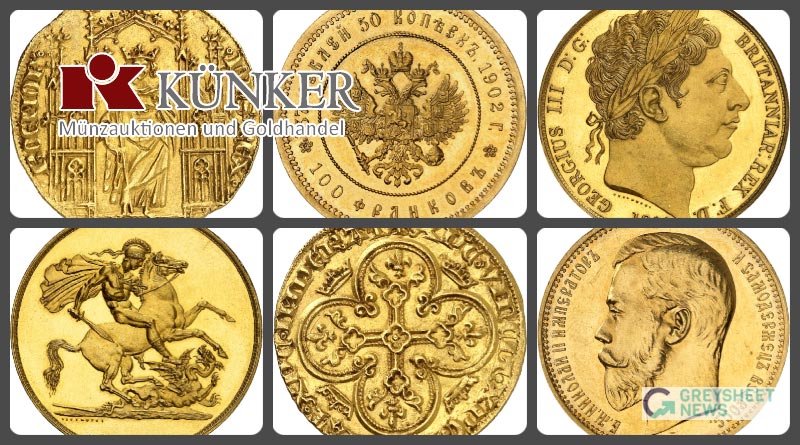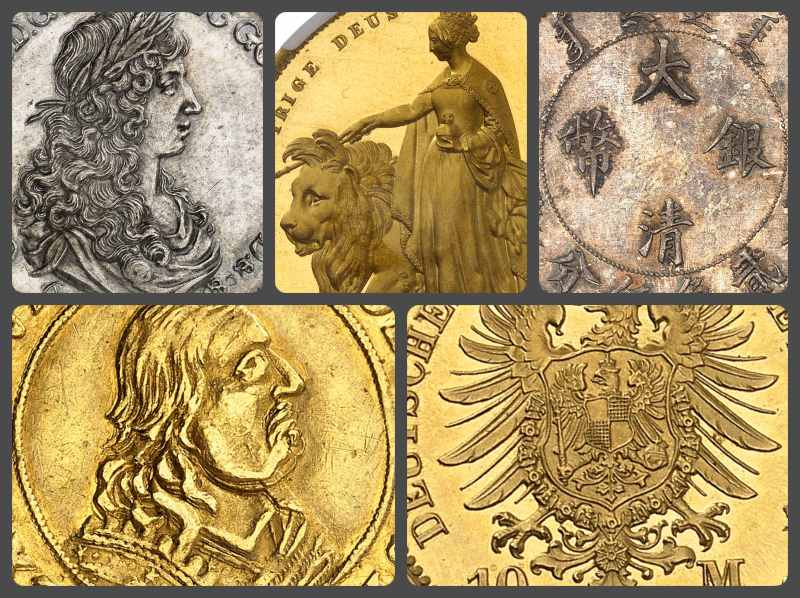Salton, Köhlmoos and the Welfs: World-Class Collections at Künker
Künker’s Spring Auction Sales will be divided into two parts. There are so many important private collections on offer that one week simply isn’t enough. The Salton and Köhlmoos Collections as well as a special collection with Welf coinage dominate the first week.
Seven extensive auction catalogs with world-class special collections: that’s just too much for a normal auction week. Therefore, Künker takes a new approach in 2022. The Spring Auction Sales will be divided into two parts. Part 1 will be held from 21 to 25 March 2022. The sale offers an important special collection containing issues of the various lines of the Brunswick principalities under the title “The Minted Splendor of the Welfs”, the second part of the Lottie and Mark Salton Collection as well as the second part of the Annemarie and Gerd Köhlmoos Collection. Added to this, there is the usual varied offer of medieval and modern coins. It includes the Dr Albrecht Ullrich Collection with Gothic gold coins of excellent quality, not to forget substantial special collections of Oldenburg and Mecklenburg coinage.
The second part of the Spring Auction Sales will take place from 4 to 6 April 2022. It is dedicated to ancient coins. On offer will be, among other things, the highly significant collection of Celtic coins from the estate of Christian Flesche, Greek and Roman coins from the Bastin, “Connaisseur” and Dr W R Collections, as well as late Roman gold coins from the Dr Albrecht Ullrich Collection. A separate preview will be published for the second part of the Spring Auction Sales.
Catalog 361: The Minted Splendor of the Welfs – An Important Special Collection
This impressive collection with coins and medals from the House of Welf comprising 791 lots covers the time frame from Henry the Lion (1142-1195) to George V (1851-1866). Numerous rare pieces of the finest quality as well as great rarities are on offer. We will limit this preview to a few extraordinary pieces. But don’t be misled! Estimates start already in the two-digit euro range.
A great rarity – there is no other term to describe the tenfold ducat from 1615 minted by Frederick Ulrich of Brunswick-Wolfenbüttel. The coin stems from the Bonin Collection and is so rare that it is listed as unique in the Friedberg catalog.
The fact that committed coin collectors have already been around in the 17th century is illustrated by a restrike of an iconic coin by Christian of Brunswick-Wolfenbüttel from the period around 1690. The daring mercenary leader of the Protestants in the Thirty Years’ War demonstratively transferred his motto “God’s friend, the priest's enemy” onto this coin. In the era of the early Enlightenment, his message was of course particularly well received by the coin-collecting educated class, which is why his issues became sought-after collectibles. And the Brunswick mint masters were glad to satisfy the demand.
In 1712, a double ducat by Anton Ulrich of Brunswick-Wolfenbüttel was made from the gold of the Lower Harz, as can be read on the coin. However, a gold medal issued by this prince in 1708 – to celebrate his 75th birthday – is even more impressive. It demonstrates his enthusiasm for ancient numismatics. In addition to the fact that the depiction was executed in the antique style, the legend refers to the ruler as “Optimus Princeps”, a title that we are familiar with from Trajan’s coinage.
Anton Ulrich died in 1714 at the advanced age of 80. He was succeeded by his son August Wilhelm – the collection contains a tenfold ducat of this ruler that is both a great rarity and of excellent quality.
The collection includes an abundance of multiple gold coins. Ferdinand Albert I of Brunswick-Bevern, for example, had an extremely rare double ducat minted in 1678 that is part of the collection, just as a tenfold ducat from 1670 from Clausthal that was commissioned by John Frederick of Brunswick-Calenberg-Hanover.
Let us conclude this series of treasures with the English Kings from the House of Hanover, who, of course, also had impressive coins and medals minted in their home land. These issues include a splendid gold medal of 25 ducats from 1701 that depicts the Great Fountain of Herrenhausen Palace on the reverse. What is remarkable about this coin is the year mentioned on it: 1701 – the fountain did not work yet at that time. Due to great technical difficulties, which could not even be overcome by the famous mathematician Leibniz, the fountain did not go into operation until 1720.
A gold medal of 50 ducats dedicated to the fact that George Louis became a member of the Electoral College was minted in 1708. Another gold medal of 50 ducats commemorates his accession to the throne of Great Britain.
No. 4: Henry the Lion, 1142-1195. Bracteate, Brunswick. Extremely rare. Beautiful patina, minor edge chips. Extremely fine. Estimate: 1,000 euros

No. 57: Brunswick-Wolfenbüttel. Julius, 1568-1589. 1 1/2 reichstaler 1587,
Wolfenbüttel. 1 1/2 Brillentaler. Extremely rare. Splendid patina,
extremely fine. Estimate: 12,500 euros
No. 95: Brunswick-Wolfenbüttel. Frederick Ulrich, 1613-1634. 10 ducats 1615, Zellerfeld. Extremely rare. Very fine to extremely fine. Estimate: 50,000 euros
No. 114: Brunswick-Wolfenbüttel. Christian, Administrator of Halberstadt, 1617-1626. 2 ducats 1622 (later restrike of the 1690s), Lippstadt. “Pfaffenfeinddoppeldukat” (Double ducat of the Catholic’s enemy). Extremely rare. Extremely fine. Estimate: 25,000 euros
No. 183: Brunswick-Wolfenbüttel. Anton Ulrich, 1704-1714. 2 ducats 1712, Brunswick. Yield of the mines in the Harz. Extremely rare. Slightly bent, about extremely fine. Estimate: 20,000 euros
No. 206: Brunswick-Wolfenbüttel. Anton Ulrich, 1704-1714. Gold medal of 50 ducats 1708, celebrating his 75th birthday, unsigned, by H. P. Großkurt. Very rare. Extremely fine. Estimate: 20,000 euros
No. 218: Brunswick-Wolfenbüttel. August Wilhelm, 1714-1731. 10 ducats 1720, Zellerfeld. Extremely rare. Extremely fine. Estimate: 40,000 euros
No. 366: Brunswick-Bevern. Ferdinand Albert I, 1667-1687. 2 ducats, 1678. Extremely rare. Extremely fine to FDC. Estimate: 20,000 euros
No. 469: Brunswick-Calenberg-Hanover. John Frederick, 1665-1679. 10 ducats 1670, Clausthal. Extremely rare. Extremely fine. Estimate: 50,000 euros
No. 607: Brunswick-Calenberg-Hanover. George I Louis, 1698-1714. Gold medal of 25 ducats 1701. Obv. Portrait of George Augustus (the later George II). Rv. Great Fountain of Herrenhausen Palace. Extremely rare. Extremely fine. Estimate: 20,000 euros
No. 615: Brunswick-Calenberg-Hanover. George I Louis, 1698-1714. Gold medal of 50 ducats 1708 commemorating his becoming a member of the Electoral College, by E. Hannibal. Probably the 2nd known specimen. Extremely fine. Estimate: 25,000 euros
No. 648: Brunswick-Calenberg-Hanover. George I Louis, 1698-1714. Gold medal of 50 ducats 1714 commemorating his taking the office as King of Great Britain, by E. Hannibal. Extremely rare. Extremely fine. Estimate: 25,000 euros
Catalog 362: The Salton Collection, Part II – European Gold Coins and Medals
The collection offered on the second auction day – on 22 March 2022 – contains world-class issues. It is so extensive that it is sold in six separate parts; moreover, there is the impressive Salton Library, which has been sold last year by Kolbe & Fanning in cooperation with Künker. Nevertheless, this preview will not focus on the coins but on the fate of this collection. For this is even more remarkable than all the rarities and showpieces with provenances that can be traced far back and estimates in the tree- to six-digit euro range.
Lottie and Mark Salton, who built this monumental collection, were from Germany. They were among the many Jews who lost relatives to the Shoah, and only escaped their persecutors at great risk and unbearable hardship. Mark Salton in particular – who was once called Max Schlessinger – has a special place in the collective memory of all numismatists. His father was Felix Schlessinger, a nephew of Leo Hamburger the Younger. Leo Hamburger brought Felix Schlessinger into his company because he had lost his son and heir in a tragic suicide. And this takes us right into the middle of the history of Germany’s most important coin dealership prior to the First World War. The auction sales of L. & L. Hamburger and Felix Schlessinger are cited in the provenance information of a myriad of great rarities in museums and private collections.
Due to National Socialism, the Schlessingers were faced with the choice of losing their livelihood and risking their lives or emigrating to Amsterdam. At great emotional and financial sacrifice, they chose emigration. But the Netherlands became a death trap. The German invasion forced Max Schlessinger to go underground whereas the German administration of the Netherlands had his father Felix and his mother Hedwig first deported to the Westerbork concentration camp, then to Theresienstadt and finally to Auschwitz. Felix and Hedwig Schlessinger were murdered in the gas chambers. Max managed to escape through France and Spain. After the war, he found a new home in the United States of America and met the love of his life: Lottie Aronstein, who had also fled to the United States at the risk of death.
It is deeply touching to see that – despite the terror they experienced – both wanted to send a message of reconciliation after their death: in their wills, Mark and Lottie Salton directed that their extensive collection should be auctioned off in the United States AND in Germany for the benefit of three non-profit organizations that commemorate the horrors of the Holocaust in order to fight against discrimination and defamation of Jews. The Künker auction house and Stack’s Bowers Galleries are proud to have been entrusted with this task.
On the occasion of the sale, Künker has published a brochure that tells the history of the Hamburger, Schlessinger and Aronstein families based on research carried out by Ursula Kampmann. Thanks to written memoirs of members of the families, we get vivid insights into the past of the three families – from the beginnings in the Hanau ghetto to the new life in the United States. The brochure can be read online at https://www.kuenker.de/data/kataloge/Kuenker_Broschuere_Salton-Collection_en.pdf.
No. 1125: Italy / Genoa. 5 doppie 1651. Purchased in 1955 by G. Williams. Very rare. About extremely fine. Estimate: 20,000 euros

No. 1197: Italy / Sardinia. Charles Emanuel III, 1730-1773. 2 1/2 doppie
1755, Turin. Specimen from the Clifford T. Weihman Collection, Stack’s
auction, New York (October 1951), No. 607. Extremely fine. Estimate: 15,000
euros
No. 1280: Netherlands / Campen. Eightfold rosenoble n.d. (1600). Imitation of the quadruple sovereign by the English Queen Elizabeth. From the stock of Felix Schlessinger’s coin dealership. Extremely rare. Extremely fine. Estimate: 250,000 euros
No. 1328: Switzerland / Graubünden – Canton. 16 francs (duplone) 1813, Bern. Calanda gold. NGC MS64 PL. Only 100 specimens minted. About FDC. 12,500 euros
No. 1362: Tyrol / Archduke Ferdinand, 1564-1595. Dreikaiserprägung (Three Emperors Issue) of 8 ducats undated (ca. 1565), Hall. From the collection of Archduke Sigismund of Austria, auction Adolph Hess Nachf, Lucerne. (14 November 1933), No. 128. Minor rim nick. Extremely fine. Estimate: 150,000 euros
No. 1371: HRE / Ferdinand III, 1625-1637-1657. 9 ducats 1629, St Veit. Very rare. Extremely fine to FDC. Estimate: 50,000 euros
No. 1387: HRE / Joseph I, 1705-1711. 10 ducats 1705, Vienna. Very rare. Extremely fine. Estimate: 60,000 euros
No. 1438: Salzburg. Matthäus Lang von Wellenburg, 1519-1540. 4 ducats 1522. From the Joseph Adolph Lindner Collection, Otto Helbing auction 15 (1899), No. 34. Very rare. NGC UNC Details – Obv cleaned. About extremely fine. Estimate: 25,000 euros
No. 1480: Bavaria. Maximilian I, 1598-1651. 8 ducats 1598 commemorating his homage, Munich. From Glendining & Co. auction, London (July 1953), No. 162. Very rare. Extremely fine to FDC. Estimate: 50,000 euros
No. 1551: Teutonic Order. Archduke Maximilian of Austria, 1585-1590-1618. 12 ducats 1614, Hall. NGC MS61. Very rare. Extremely fine. Estimate: 50,000 euros
No. 1628: Regensburg. 8 ducats n.d. (1745-1765). From the Brunner Collection, Otto Helbing auction 51 (1927), No. 1430. Very rare. NGC MS61+. About FDC. Estimate: 50,000 euros
No. 1635: Saxony. John George I and Augustus, 1611-1615. Sixfold ducat klippe 1614 on the crossbow shooting at the christening of Prince Augustus, Dresden. Very rare. Extremely fine. Estimate: 75,000 euros
Catalog 363: World Coins and Medals / German Coins after 1871
On 23 and 24 March 2022, Künker’s auction sale 363 will take place. It contains world coins and medals with estimates starting in the three-digit euro range, although – of course – there are great treasures to be found here too.
Auction 363 also offers some impressive collections including the Dr Albrecht Ullrich Collection with Gothic gold coins – especially from France, Flanders, Brabant, Hainaut and England. Furthermore, special collectors will find an extensive offer of Russian gold and silver coins of about one hundred lots.
The major part of the material is from the German States. Experts will spot exciting individual pieces as well as extensive collections of Brunswick lösers and coins from Mecklenburg and Oldenburg.
A broad selection of German coins after 1871 including many rarities rounds off auction 363.
No. 2015: Flanders. Louis of Male, 1346-1384. 1/2 Lion d’or n.d. (1365), Gent. From the Dr Albrecht Ullrich Collection. Very rare. Extremely fine to FDC. Estimate: 7,500 euros
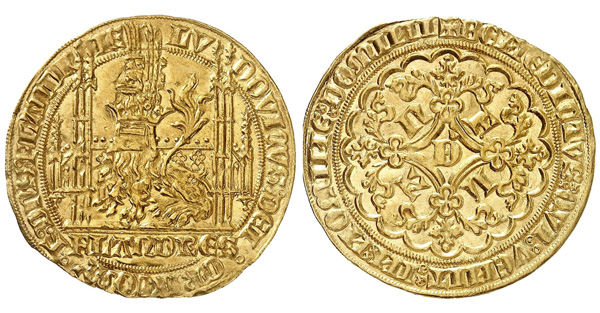
No. 2030: France. Philippe IV, le Bel, 1285-1314. Masse d’or n.d. (1296).
From the Dr Albrecht Ullrich Collection. Very rare. Extremely fine.
Estimate: 7,500 euros
No. 2168: Russia. Peter III, 1762. 10 roubles 1762, St. Petersburg. Very rare. Traces of mounting. Edge worked. Worn. Very fine. Estimate: 7,500 euros
No. 2333: Austria. Franz Joseph I, 1848-1916. Off-metal strike in gold from the dies of the 4 krajczár copper coin from 1868, Kremnica. From the collection of the Egyptian King Farouk, Sotheby’s (February 1954), No. 966. Only a few specimens known. Miniscule scratches. Proof. Estimate: 60,000 euros
No. 2414: German States / Mainz. Anselm Franz von Ingelheim, 1679-1695. Off-metal strike in gold of 5 ducats from the dies of the reichstaler from 1682, Mainz. From Grabow auction 1 (1921), No. 237; Künker auction 80 (2003), No. 2237. Probably unique. PCGS MS63. Extremely fine to FDC. Estimate: 50,000 euros
No. 2429: German States / Nuremberg. 4 ducats 1631. Extremely rare. NGC MS63. FDC. Estimate: 75,000 euros
No. 2592: Russia. Aleksey Mikhaylovich, 1645-1676. Jefimok 1655, overstrike on a reichstaler n. d. of Nuremberg. Very rare. Very fine. Estimate: 3,000 euros
No. 2684: China. 50 cents (1/2 dollar) n.d. (1910), Tientsin pattern with smooth edge. Extremely rare. NGC PF64* CAMEO. Proof. Estimate: 20,000 euros
No. 2825: Brunswick and Lüneburg. Rudolf August, 1666-1685. Löser of 4 reichstalers 1679, Zellerfeld. Very rare. PCGS MS61. Extremely fine. Estimate: 30,000 euros
No. 2931: Mecklenburg. Christian Louis I, 1658-1692. Oval, gilded silver medal n.d. (1662), commemorating the Duke’s entry to Rostock, by J. Reteke. From the Popken Collection, Künker auction 57 (2000), No. 155. Very rare. Original strike. Old gilding. Very fine. Estimate: 5,000 euros
No. 2940: Mecklenburg. Frederick William, 1692-1713. Reichstaler 1708, Schwerin. Extremely rare. Extremely fine. Estimate: 4,000 euros
No. 3024: Oldenburg. Anton I, 1526-1573. Taler n.d. (1538). Very rare. Very fine. Estimate: 10,000 euros
No. 3305: German New Guinea. 20 New Guinean marks 1895. Only 1,500 specimens minted. NGC MS66+. About FDC. Estimate: 40,000 euros
Auction 364: From the Taler to the Mark – German Coins after 1800 from the Annemarie and Gerd Köhlmoos Collection
On 26 January 2022 the first part of the second Köhlmoos Collection was sold and achieved an incredibly impressive result. The hammer price was 40% more than the estimate and amounted to more than 2.8 million euros. This was mainly due to the fact that “from the Köhlmoos Collection” has already been synonymous with perfect quality among coin collectors since the first Köhlmoos Collection was auctioned off in 2001. Coins “from the Köhlmoos Collection” are of the best quality there is for a specific coin type. Frequently, the coins come with the additional bonus of a fine toning. This also holds true for the coins of auction 364, which will be held on 25 March 2022. This time, the topic is German coins after 1800. They document the monetary history of the evolving federal state up to and including the introduction of the Deutsche Mark.
The Köhlmoos couple focused on silver and base metals. They collected both taler-size coins and fractional pieces. However, commemorative coins – which could already be found in relatively large quantities in circulation in the 19th century – are missing, except for a few coin types. Therefore, the Köhlmoos Collection Part 2 is like a family album of the Deutsche Mark: it shows the various ancestors that were necessary to get to a common currency.
No. 4014: Baden. Charles Frederick, 1746-1811. Konventionstaler 1803. From the Virgil M. Brand Collection, part 5, Leu auction 70 (1997), No. 5739. Only 675 specimens minted. Proof. Estimate: 10,000 euros
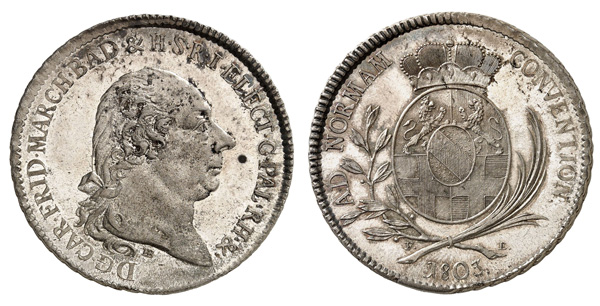
No. 4063: Bavaria. Ludwig II, 1864-1886. Double vereinstaler 1865. Only
2,490 specimens minted. About FDC. Estimate: 12,500 euros
No. 4072: Brunswick. Charles II, 1815-1830. Under the guardianship of King George IV of Great Britain, 1820-1823. Speciestaler 1821. Very rare. About FDC. Estimate: 7,500 euros
No. 4205: Prussia. Frederick William III, 1797-1840. Taler 1816A, kammerherrentaler. Extremely rare. Extremely fine to FDC. Estimate: 6,000 euros
No. 4277: Saxe-Coburg-Gotha. Ernest I, 1826-1844. Konventionstaler 1832. Only 304 specimens minted. First strike, FDC. Estimate: 20,000 euros
No. 4341: Westphalia. Jérôme Napoleon, 1807-1813. Konventionstaler 1810 C. Very rare. About FDC. Estimate: 25,000 euros
No. 4348: Württemberg. Frederick I, 1806-1816. Konventionstaler 1806. Extremely rare. About FDC. Estimate: 25,000 euros
No. 4459: German Empire. 1/2 marks 1908F. Extremely rare. Proof. Estimate: 6,000 euros
No. 4497: German Empire. Frederick I, 1852-1907. 5 marks 1902. Only few specimens minted. Proof. Estimate: 10,000 euros
No. 4607: Weimar Republic. 50 reichspfennig 1924 F. Very rare. Proof. Estimate: 10,000 euros
No. 4633: Weimar Republic. 5 reichsmarks 1933 J. Very rare. Proof. Estimate: 10,000 euros
Catalog 365-367: Ancient Coins and Medals
From 4 to 6 April 2022, three Künker auction sales will take place offering ancient coins of the finest quality. Special highlights are the Dr Guy Sylvain Paul Bastin Collection with Greek coins of exquisite quality, the Christian Flesche Collection with Celtic coins as well as late Roman gold coins from the Dr Albrecht Ullrich Collection and Roman coins – mainly sesterces of exceptional quality – from the collection of a connoisseur. A separate auction preview will be published for these three auctions.
No. 5236: Agrippina Mater. Sestertius, 50-54. From the collection of a connoisseur. Rare. Extremely fine. Estimate: 10,000 euros
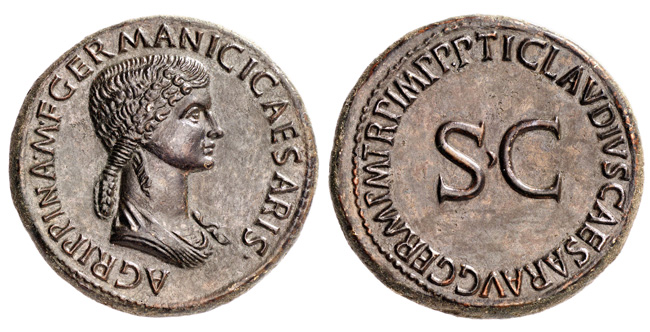 No. 6365: Germany. Vindelici. Gold stater, 150-50 BC. About extremely fine.
Estimate: 5,000 euros
No. 6365: Germany. Vindelici. Gold stater, 150-50 BC. About extremely fine.
Estimate: 5,000 euros
No. 7081: Sicily / Syracuse. Republic, 214-212. 16 litre. From Lanz auction 97 (2000), No. 107. Very rare. Extremely fine. Estimate: 10,000 euros
To order a catalog contact Künker, Nobbenburger Straße 4a, 49076 Osnabrück; phone: +49 541 962020, fax: +49 541 9620222; or via e-mail: service@kuenker.de. You can access the auction catalogs online at www.kuenker.de. If you want to submit your bid from your computer at home, please remember to register for this service in good time.

Download the Greysheet app for access to pricing, news, events and your subscriptions.
Subscribe Now.
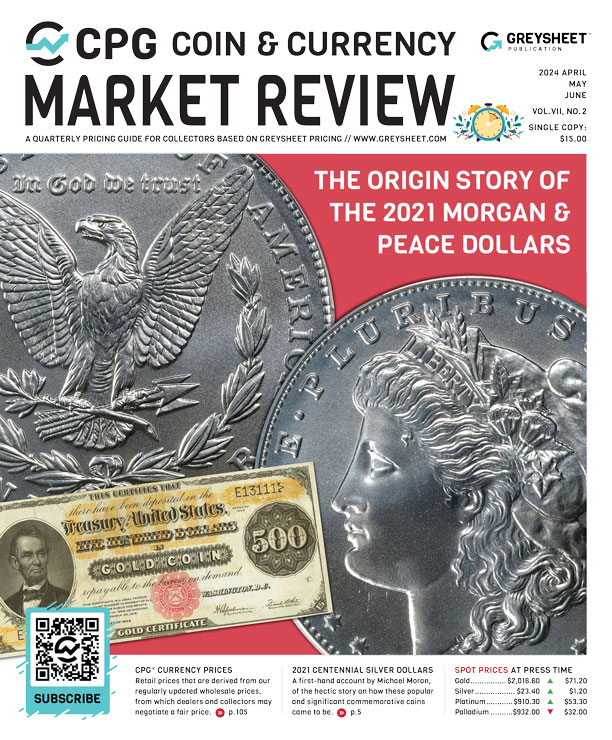
Subscribe to CPG© Coin & Currency Market Review for the industry's most respected pricing and to read more articles just like this.
Source: Fritz Rudolf Kuenker GmbH and Co. KG









